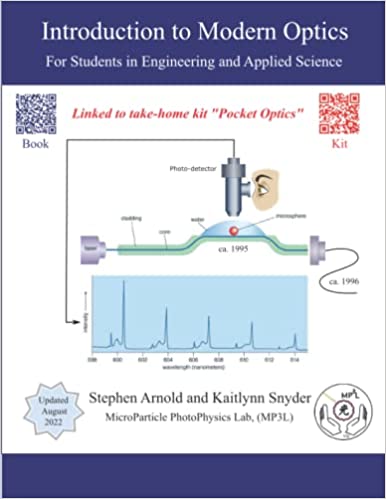A disruptive approach to teaching and textbooks
Professor of Applied Physics Stephen Arnold includes innovative home lab kit with his textbook on modern optics

A “pocket optic” kit allows students to perform a series of hands-on experiments to illustrate the concepts outlined in Stephen Arnold's textbook.
Years ago, University Professor and Thomas Potts Professor of Applied Physics Stephen Arnold had an epiphany that changed his thoughts on pedagogy.
In his own words:
Some years ago, I was riding to work on the New York City subway, when a vendor walked through displaying his wares. He had spinning tops and laser pointers for sale, and while the tops appealed to me, I bought a laser pointer, since I was scheduled to be on an oral exam committee that afternoon for an electrical engineering doctoral candidate, and I thought it might come in handy.
That afternoon, one of the other committee members asked a question about how the polarization of the electrical field in a beam of light changes upon reflection from a dielectric surface. The Ph.D. candidate showed his understanding of theory and derived a bunch of equations in just under an hour.
The student’s advisor nudged me to ask the next question, and I thought about the laser pointer that I had just purchased and placed in my pocket on the subway, wondering whether it was polarized. Instinctively, I pulled it from my pocket, placed it on the table, and asked the student to tell us. I was surprised when the response was that he had no polarizer.
I pointed out that he had just spent an hour talking about what polarized light would do upon reflection from a dielectric surface. He hemmed and hawed for the next few minutes, finally replying that to use the theory, he would require a beam, whereupon I told him to press the button on the laser pointer. When he did, a beam of light emanated, and when he again asserted that he lacked a polarizer, I directed his attention to the fact that there were dielectric surfaces on the front of picture frames, several of which were hanging on the walls of the room.
As he hemmed and hawed for the next several minutes, his adviser’s face reddened in discomfort. Ultimately, the committee politely dismissed the student from the room and graded the oral exam. The adviser ruled that the student should not be awarded a Ph.D. without passing a lab course, and that experience stuck in my memory.
 Later, when Arnold was asked by the chair of Tandon’s Department of Applied Physics to teach a course on optics, he agreed, but only on the condition that he could write his own textbook and couple it with practical, take-home labs. He ultimately authored that text, Introduction to Modern Optics for Students in Engineering and Applied Science, with Kaitlynn Snyder, then in her junior year — an assignment virtually unheard of for an undergraduate. She later received a Henry M. MacCracken Program Fellowship, including full scholarship, to pursue her doctoral degree in physics, thanks in part to that rare accomplishment.
Later, when Arnold was asked by the chair of Tandon’s Department of Applied Physics to teach a course on optics, he agreed, but only on the condition that he could write his own textbook and couple it with practical, take-home labs. He ultimately authored that text, Introduction to Modern Optics for Students in Engineering and Applied Science, with Kaitlynn Snyder, then in her junior year — an assignment virtually unheard of for an undergraduate. She later received a Henry M. MacCracken Program Fellowship, including full scholarship, to pursue her doctoral degree in physics, thanks in part to that rare accomplishment.
That left the issue of the take-home labs: Arnold enlisted the help of a business-minded former doctoral student, David Keng, who is now successfully marketing “pocket optic” kits, which include transmission diffraction gratings, a polarizer, a red laser, an aspheric lens, a one-inch-diameter acrylic sphere, and dye solutions. Available along with the textbook, the kit allows students to perform a series of hands-on experiments to illustrate the concepts outlined in the volume. (In one, students can turn their smartphones into microscopes; in another, a phone is employed as a photometer.)
Arnold — who accepts no profits from the kits, preferring Keng to benefit from his entrepreneurial efforts — has found the combination of textbook and home labs to be a rousing success among students at all levels. “As far as I know, Tandon is the only school offering optics courses that make use of a text and at-home kit of this sort,” he says. “I hope it encourages other professors and schools to innovate in similar ways.”
Encouraging invention
Arnold recently announced that he was funding a new annual competition: the AG Invention Award in Applied Physics, which is named in honor of his father and which will provide $5,000 to a junior or senior who creates a marketable product or process based on “First Principles Thinking.”
“There are about 10 basic equations that physicists know well, such as Newton’s Laws that describe the motion of satellites or the Schroedinger equation that is key to quantum mechanics,” Arnold explains. “In Physics, First Principles Thinking involves breaking down complicated problems into basic elements like those and finding solutions. With the right mindset, our applied physics students should be able to come up with useful ideas that have real-world applications.”
For more information on the award, contact sa1577@nyu.edu.




